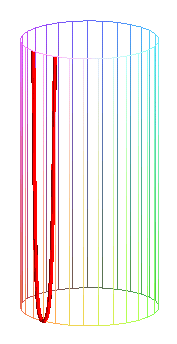According to the formulas
| next curve | previous curve | 2D curves | 3D curves | surfaces | fractals | polyhedra |
PSEUDOGEODESIC of a surface
| Notion studied by W.
Wunderlich in 1951.
See also Erwin Kruppa, Analytische und konstruktive Differentialgeometrie, p. 159. |
The pseudogeodesic lines
of a surface are the curves traced on the surface the osculating planes
of which form a fixed angle
with the tangent plane of the surface; when this angle is a right angle,
we get the proper geodesic and when it is
equal to zero, the asymptotic lines.
According to the formulas ,
,
(see the notations),
they are the curves for which the normal curvature, or the geodesic curvature,
is proportional to the curvature, or for which the geodesic torsion is
equal to the torsion.
| Computation of the pseudogeodesics in the case of a vertical cylinder
(see the notations).
The first principal curvature But For a cylinder of revolution, |
Example: the proper pseudogeodesic of the cylinder of revolution are the curves that develop onto catenaries with axis parallel to the axis of the cylinder (therefore, special case of generalized catenaries). Equations:
| Parametrization where Opposite, animation for See here the surface folded along this curve. |
 |
| next curve | previous curve | 2D curves | 3D curves | surfaces | fractals | polyhedra |
© Robert FERRÉOL 2018